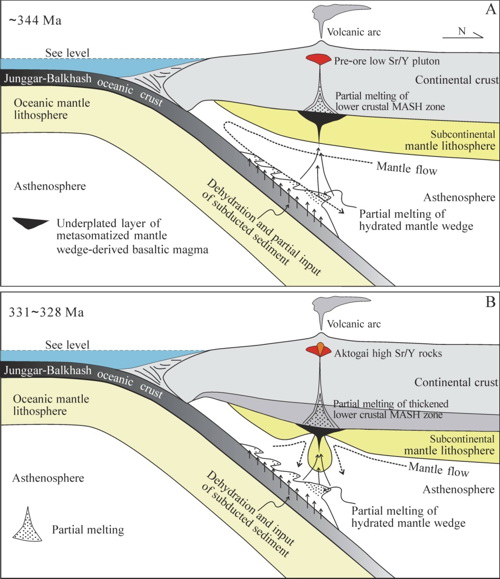Researchers Uncover the Formation Mechanism of Giant Aktogai Cu DepositUpdate time:09 19, 2016
Prophyry Cu Ore (Image: Shibangchina.com) Porphyry Cu deposits are one of the world’s most valuable ore deposits providing around 75%, 50% and 20% of the world’s supply of copper, molydbenum and gold, respectively. Most ore-forming porphyries that are associated with large to giant oxidized porphyry Cu deposits at subduction zone have an affinity with high Sr/Y or adakitic rocks (Fig. 1), while barren or weakly mineralized granitoids typically have low Sr/Y features. However, the internal formations mechanisms remain poorly understood. Associate Prof. CAO Mingjian, LI Guangming, Prof. QIN Kezhang, Institute of Geology and Geophysics, Chinese Academy of Sciences (IGGCAS), and other co-workers, have undertaken a geochronology, mineral chemistry and geochemistry study on pre-ore and ore-forming rocks to reveal the formation mechanisms at the Giant Aktogai porphyry Cu deposits. This work was published in American Journal of Science. The zircon ages show that the pre-ore rocks and ore-forming porphyries formed at 344.7 and 327.7 to 331.4 Ma, respectively. Combed with previous ages (> 368 Ma), the arc-related magmatism continued for at least 40 Ma, indicating a long-lived subduction zone. Distinctly higher apatite SO3 content in the ore-forming porphyries and whole rock apatite saturation temperature relative to the pre-ore rocks suggest an increase in oxygen fugacity (fO2) and temperature during the petrogenesis of the ore-forming rocks. Whole rock geochemistry indicates that the pre-ore rocks and ore-forming rocks have different geochemistry (low Sr/Y and high Sr/Y rocks, respectively), but both have similar isotopic (Sr-Nd-Pb-Hf-O) compositions. Very young whole rock Nd and zircon Hf model ages of 320 to 680 Ma indicate that they were come from the similar source ─ from a newly formed lower crust. They proposed that the pre-ore low Sr/Y rocks were probably formed by partial melting of normal thick juvenile lower crust under relatively reducing condition during subduction, while the high Sr/Y rocks were generated by partial melting of thickened, eclogitized and sulfide-rich juvenile lower crust under high oxidizing and temperature condition (Fig. 2). This work confirms that highly oxidized and high Sr/Y rocks have higher mineralization potential than relatively reduced rocks with low Sr/Y ratios. In addition, the high oxygen fugacity conditions of high Sr/Y rocks might be the intermal mechamisn of generating significant mineralization. Furthermore, long-lived subduction zones are potential regions to find large porphyry Cu deposit. The study was done in collaboration with associate Prof. EVANS Noreen J.from Curtin University, Australia, and Prof. SEITMURATOVA Eleonora Yusupovha from K. Satpaev Institute of Geological Sciences, Kazakhstan. The work was supported by National Natural Sciences Foundation of China (41402081, 41390444) and Special Fund for Scientific Research in the Public Interest of Ministry of Land and Resources of China (201411024-5).
Fig. 1. Plot of Yttrium versus Strontium for samples associated with giant porphyry Cu deposits from all over the world (image from Porphyry Copper Deposit Model, 2010).
Fig. 2. Schematic illustration showing the petrogeneticmodels for the pre-ore rocks and ore-forming high Sr/Y porphyries at the Aktogai deposit.
|
Contact
CAO Mingjian
Division: Solid Mineral Resources Group: Orogenic belts and ore-forming processes Phone: 86-10-82998190 E-mail: caomingjian@mail.iggcas.ac.cn Related Articles
Reference
|
-
SIMSSecondary Ion Mass Spectrometer Laboratory
-
MC-ICPMSMultiple-collector ICPMS Laboratory
-
EM & TEMElectron Microprobe and Transmission Electron Microscope Laboratory
-
SISolid Isotope Laboratory
-
StIStable Isotope Laboratory
-
RMPARock-Mineral Preparation and Analysis
-
AAH40Ar/39Ar & (U-Th)/He Laboratory
-
EMLElectron Microscopy Laboratory
-
USCLUranium Series Chronology Laboratory
-
SASeismic Array Laboratory
-
SEELaboratory of Space Environment Exploration Laboratory
-
PGPaleomagnetism and Geochronology Laboratory
-
BioMNSFrance-China Bio-mineralization and Nano-structure Laboratory

 Print
Print Close
Close


